The 2024 Art Biennale with the theme ‘Foreigners Everywhere – Stranieri Ovunque’ is again overwhelming and has so many beautiful artworks to discover. There is a wide variety of contemporary art, including paintings, photography, multimedia, installations, sculptures and conceptual art. Out of the huge number of exhibitions, I selected 5 pavilions which really inspired me. The one of the Holy See in the women’s prison is by far my number one for this year.
Holy See: With My Eyes
The Holy See has once again created a memorable exhibition for the Biennale. The theme of human rights and people living on the margins of society has been perfectly integrated in every aspect of the exhibition such as the location in the women’s prison, the female prisoners as guides and artworks created in collaboration with the prisoners. Even though the focus is on the artworks, the women share how they relate to it and share some insights on the life inside which makes it very emotional and confrontational at times.
Paintings with handwritten phrases visualize the feelings of the prisoners and have been painted by Simone Fattal. During the tour, you could see and feel how important it was for these women to be heard and they were proud that these works of art will now forever tell their story. The stunning paintings of Claire Tabouret are based on pictures of the prisoners as children and of their own children. The artwork of a neon eye from Claire Fontaine stands for self-reflection and looking at the future, but they admitted that they don’t want to think too much and sometimes prefer to stay inside instead of being released into a world full of wars and diseases. The large phrase of Claire Fontaine with the words ‘siamo con voi nella notte’ (we are with you at night), which is displayed on the inner court, gives them support when they need it. The short film Dovecote by Marco Perego is shot in the prison and gives a glimpse of the life inside. All the actors are prisoners, with the exception of the main character.
When we watched the vegetables garden from behind a window and one of the women said this is the only place where they can look outside without bars, you realize this is much more than an art tour. It makes you feel like a foreigner and an intruder, exactly as in Adriano Pedrosa’s statement. This is for me the perfect translation of the theme into a pavilion.
Reservations are required for this tour. As they fill up quickly, it’s best to book a couple of weeks in advance. Be aware that the tours are in Italian (or sometimes in an additional language depending on the guides).
Location: Fondamenta delle Convertite, Giudecca (vaporetto stop Giudecca Palanca)
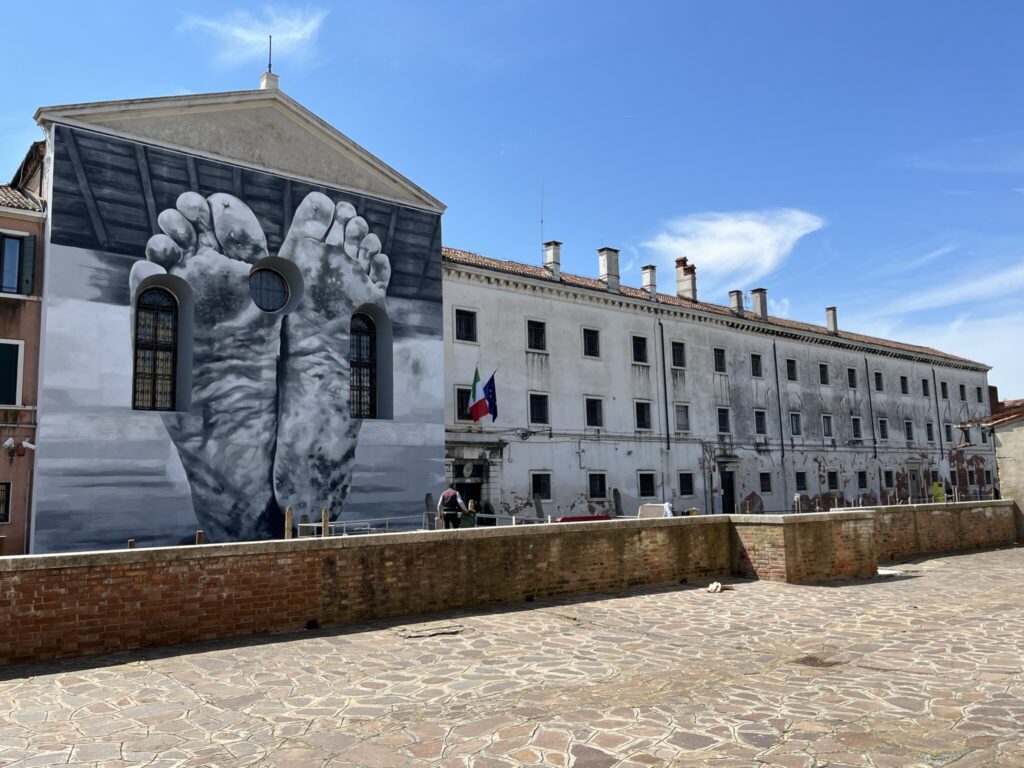
Romania: What Work Is
Șerban Savu’s exhibition ‘What Work Is‘ is centered around the history and relationship of work and leisure. It is spread across two locations: the Romanian pavilion in Giardini and a workshop in Cannaregio.
I was driven to the exhibition by the desire to discover Șerban Savu’s modern mosaics, but the huge polyptych with 45 paintings blew me away as soon as I entered the pavilion. His paintings show different situations between work and rest. You see for instance men sleeping on a bench, on a grass field or in a bed, men sunbathing, people painting religious artworks, men working on a house or pulling cables or children playing. These day-to-day situations have several references to religious paintings and resemble historical iconographic works.
The paintings were made over a period of 15 years, but it seems as if they were all made for this exposition. They blend perfectly together as they are all in the same style and neutral color palette.
There are also four architectural models adorned with mosaics, in the same theme of work and leisure. This refers to the second part of the exhibition where a temporary mosaic workshop reflects the spirit of the small Venetian manufacturing workshops. Over the course of the Art Biennale, students and professors of Moldova will replicate True Nature, a painting of Savu in a large-scale mosaic (four by five metres).
The combination of 45 stunning works, the sublime composition of these paintings in the polyptych and the perfect fit in the pavilion make this exhibition a must-see for this year.
Location: Giardini and The New Gallery of the Romanian Institute of Culture and Humanistic Research in Venice, Palazzo Correr, Campo Santa Fosca, Cannaregio 2215
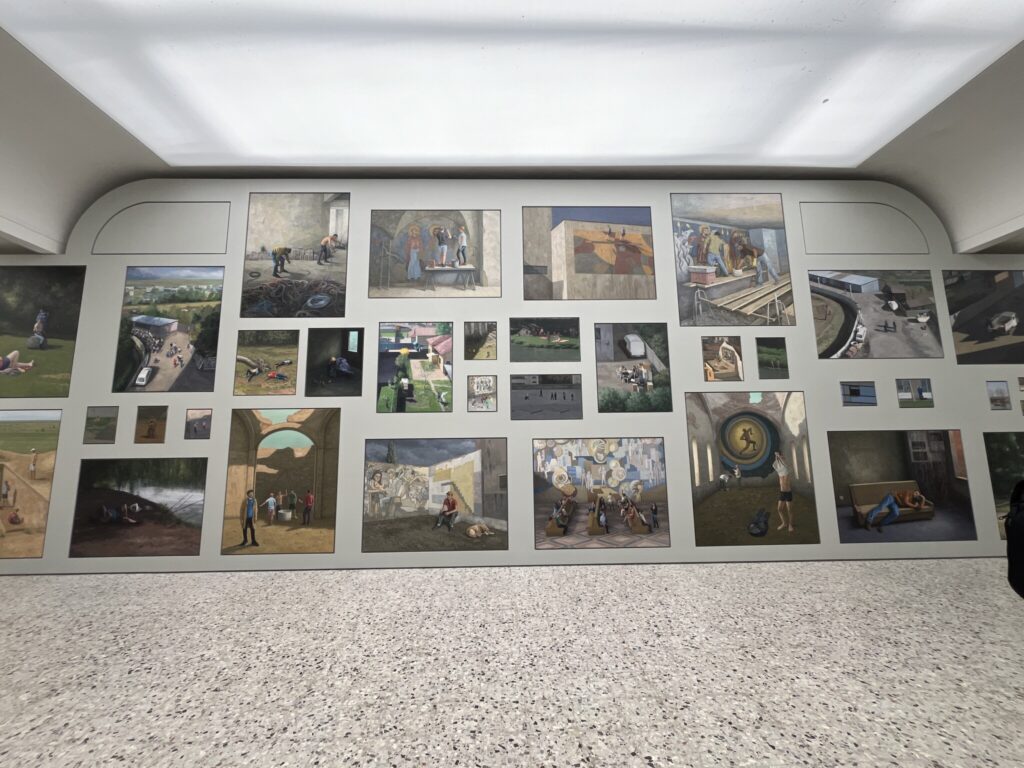
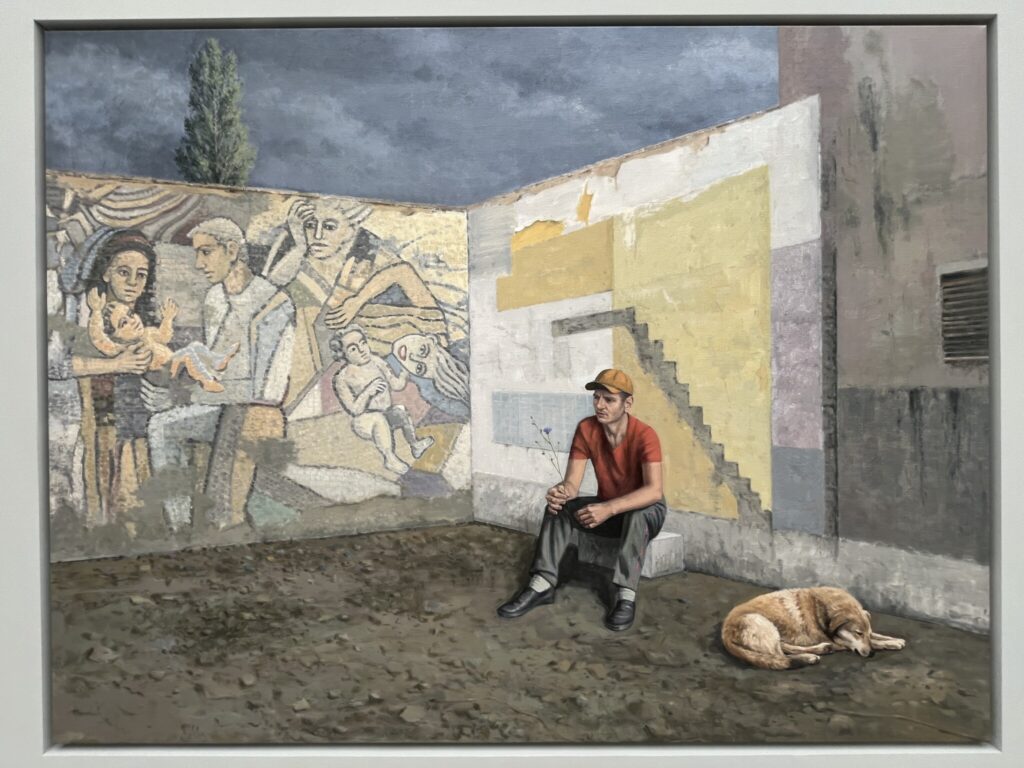
Malta: I will follow the ship
The multimedia installation ‘I will follow the ship’ is a perfect example of how new technologies do not only give artists better tools but can actually be part of the art creation itself.
Matthew Attard presents digital drawings of ships which are created by himself, by an eyetracker which follows his eye movements and transforms them in data points and by AI (artificial intelligence) which uses data from historical images of ships. The combination of these three elements leads to the continuous drawings on the large screen, from a few dots to entire ships. Each sequence is different so you can continue to watch ships appear and disappear while trying to understand what’s happening.
The ‘I’ in the title of the exhibition does not only refer to the artist (or you as the spectator), but also to the eye (tracker). For me, it could also refer to the (A)I used. I find this evolution very intriguing and would love to grasp this technological process and its potential for art in the future.
The other sections of the pavilion are overshadowed by the continuously changing sea landscape, but they can be useful to watch as background information. There are pen-plotted drawings of images of old ships, based on drawings found on chapels of the Maltese islands. On the other side, you can find screens that dissect the eye-tracking process.
Location: Arsenale
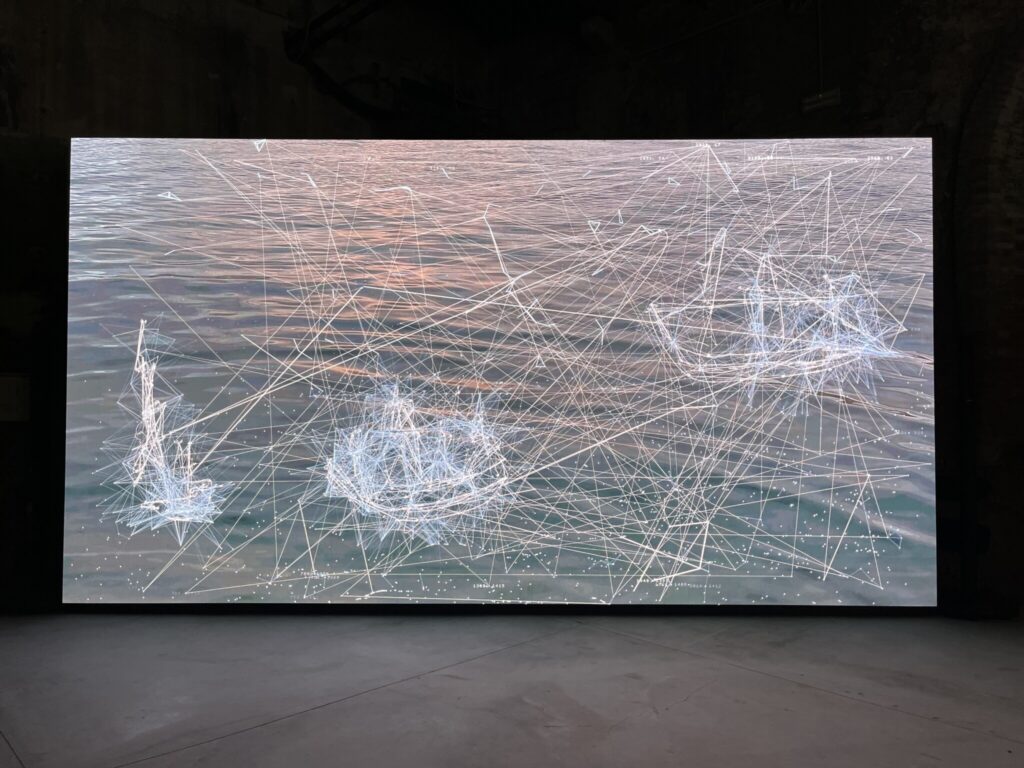
United States: the space in which to place me
The pavilion of the United States has for the occasion been hand-painted in bright red and other vibrant colors. This is only the prelude of the eclectic paintings and sculptures inside. Just looking at these will make you smile.
Jeffrey Gibson celebrates individuals and communities who have maintained their dignity and traditions in impossible circumstances. The large figures in the first room refer for instance to the Indian Citizenship Act, which grants indigenous people basic rights, and the Civil Rights Act, which affords all citizens equal protection under the law. Even though the underlying messages are less positive, he seems to put a lot of focus on what you (as a foreigner in whatever context) can do and that you shouldn’t let others define who you are.
He envisions an inclusive future in which all people are seen, accepted, and loved. The typographic styled sentences hidden in the indigenous aesthetics of the paintings are sometimes difficult to decipher, but the signs and the beautifully designed booklet can help you. These messages are taken from a mix of texts from songs, Dakota proverbs, excepts from legislative documents … , which he all puts at the same level, similar to his inclusive vision of people.
The vividity of the pavilion really makes it stand out from all the others, which is enough reason not to miss it. Don’t let the kaleidoscopic element scare you. I was certainly pleasantly surprised.
Location: Giardini
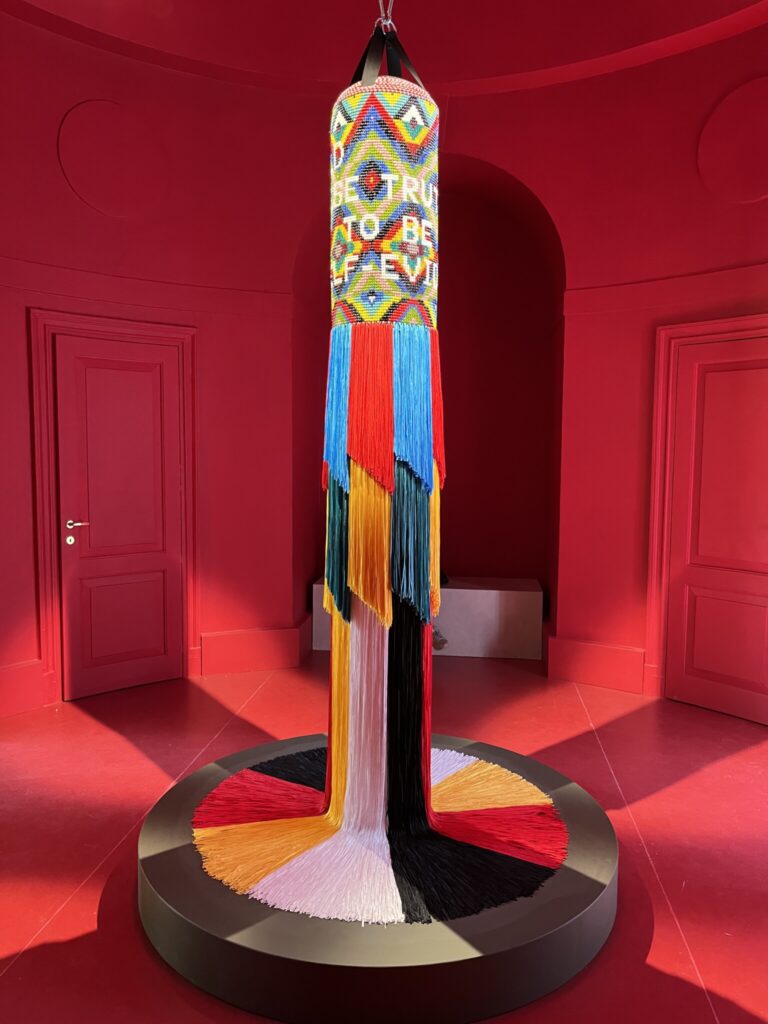
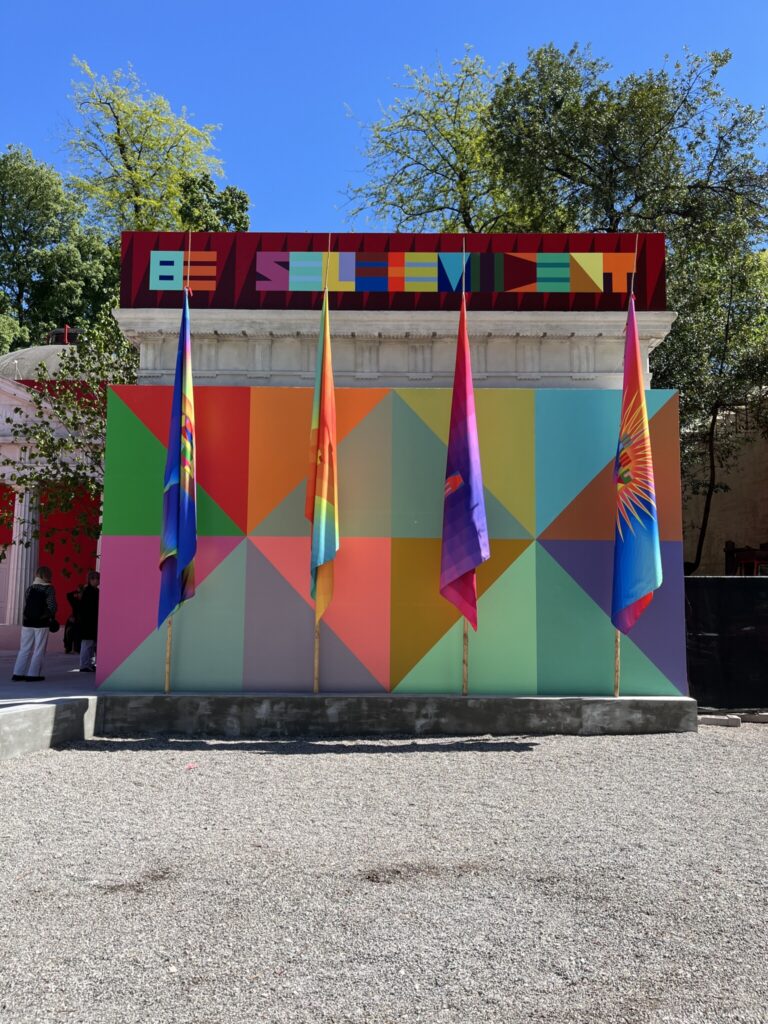
Australia: kith and kin
Aboriginal artist Archie Moore uses a black and white installation to explain the wealth and sheer size of relationships as well as to question the rights and unequal treatment of first nations people (i.e. this term refers to indigenous people, ethnic groups who are the earliest known inhabitants of an area).
Kith and kin means friends and family. In the 14th century, kith also meant ‘countrymen’ and ‘one’s native land’, which implies an attachment to place, people and time. First nations people of Australia are among the oldest continuous living cultures on earth. The family tree which Archie Moore has written on the black walls with chalk contains 3,484 names, combining Kamilaroi and Bigumbal names from his mother’s family and British and Scottish names from his father’s side. Families of first nations people are much larger as they can call more than one person mother, father or brother. It is therefore almost certain that some family ties have been wrongly noted by the officials who didn’t have this indigenous background.
The piles of white papers above the black water pool are coroners’ reports and archival material of the artist’s family. It is a memorial for first nations people who died in police custody since 1991. They are one of the most incarcerated people globally. Even though they represent only 3.8% of the Australian population, 33% of the prison inmates are first nations people.
With this installation, he shows in a restrained way the impact of racism on aboriginals in Australia, even in current years. Many of the recommendations of the Royal Commission into Aboriginal Deaths in Custody 1987-1991 have still not been implemented.
The black color of the exterior of the pavilion now also dominates the entire interior. The completely black pavilion also reflects how you feel when you start thinking about the underlying messages of the artist.
The Australian pavilion won the Golden Lion for Best National Participation with this ‘kith and kin’ exhibition.
Location: Giardini
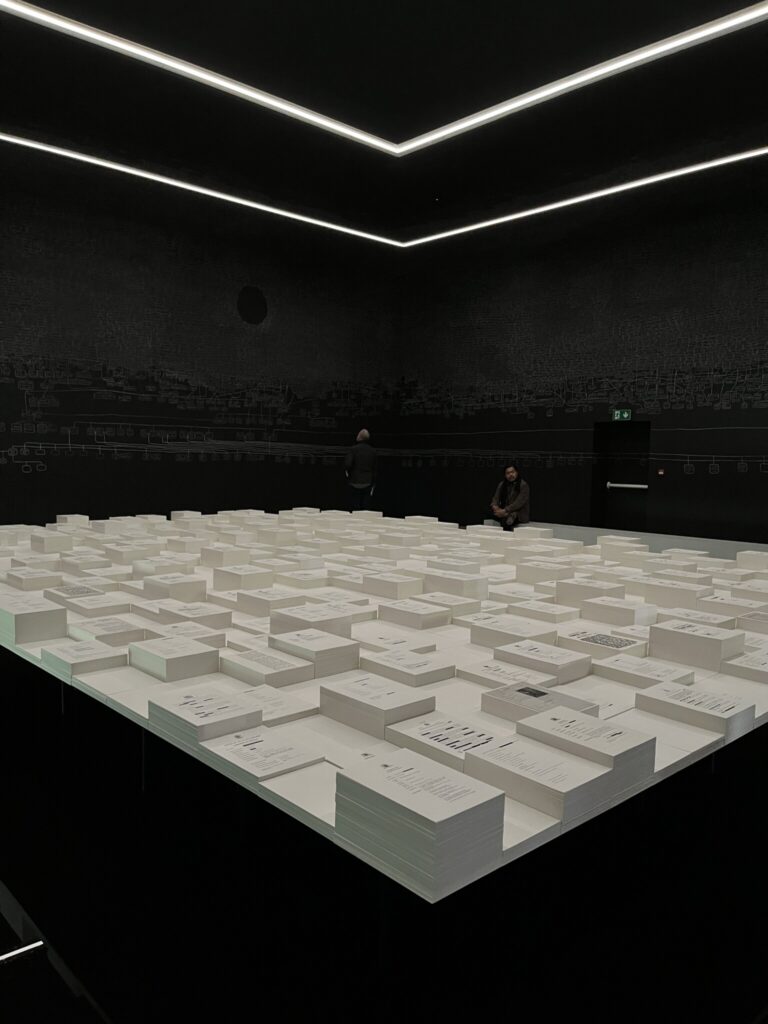
There are however many more interesting pavilions and artworks to be discovered this year. Feel free to share your favorite ones in the comments below.
Before your visit, you also might want to read my posts ‘What to expect from the Art Biennale 2024’ which gives you more information on the theme ‘Foreigners Everywhere – Stranieri Ovunque’ and curator Adriano Pedrosa, and ‘How to prepare your visit to the Art Biennale 2024’ with practical information such as on tickets and locations.
I also share more stunning artworks, extraordinary locations and pavilions with strong messages in my guide ‘The insider guide to the Venice Art Biennale 2024’.
Enjoy the Biennale!

It is such a pleasure to read these – from an art appreciator’s eye rather than an art critic! Inspiring and thoughtful.
Thanks Virginia for the nice compliment. I really appreciate it 🙂
Thanks for sharing. Can’t wait to be back in Venice, and I’ll definitely be going to the women’s prison exhibition.
Trish,
I’m sure you will like it. Don’t forget to register ahead of time, so you are sure to be able to visit.
Enjoy your trip!
Katia